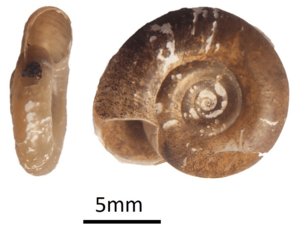Biomphalaria sudanica facts for kids
Quick facts for kids Biomphalaria sudanica |
|
|---|---|
 |
|
| Apical and apertural view of Biomphalaria sudanica | |
| Scientific classification |
Biomphalaria sudanica is a type of freshwater snail. It breathes air and lives in water. This snail belongs to a group called "ram's horn snails" because of its shell shape.
It has a flat, brown shell, usually about 9 to 11 millimeters wide. Biomphalaria sudanica is important because it can carry tiny parasites. These parasites can cause a disease in humans.
Contents
Where Biomphalaria sudanica Lives
Biomphalaria sudanica is found in Africa. It lives in freshwater places like rivers, streams, ponds, and the big African Great Lakes.
These snails like slow-moving water with lots of plants. They eat algae and tiny bits of decaying matter. Their head has two feelers with eyes at the bottom. They also have a tube for breathing and getting rid of waste.
Places Where They Are Found
You can find Biomphalaria sudanica mainly in East Africa:
- The River Nile in Shambat, Sudan.
- Lake Albert in Uganda. (This lake is between Uganda and the Democratic Republic of the Congo).
- Lake Kyoga in Uganda.
- Lake Ziway in Ethiopia.
How Biomphalaria sudanica Lives
Biomphalaria sudanica plays a role in its watery home. It helps keep the water clean by eating algae and dead plant bits. Many animals, like fish, birds, and other small creatures, also eat these snails.
Carrying Parasites
This snail is known to carry tiny worms called Schistosoma mansoni. These worms are parasites, meaning they live off other living things. They cause a disease in humans called intestinal schistosomiasis.
The snail helps the parasite complete its life cycle. If people touch water with these infected snails, they can get the disease.
Living in Water
Biomphalaria sudanica lives in shallow water near the shore, for example, in Lake Albert. Even though it breathes air, it can use oxygen from the water very well. This helps it live in swampy areas.
The number of Biomphalaria sudanica snails changes throughout the year. In Lake Ziway, Ethiopia, there are usually the most snails from June to August. This is at the end of the rainy season. Scientists have also found that snails have bigger shells in water with more calcium.
Why Biomphalaria sudanica Is Important
Biomphalaria sudanica is not in danger of disappearing. Its numbers are steady where it lives naturally. However, because it carries the parasites that cause schistosomiasis, it's a key target for disease control.
Scientists and health workers try to lower the number of snails. They use special treatments or other living things to control the snail population. This helps reduce the spread of schistosomiasis.
Besides Schistosoma mansoni, this snail can also carry another parasite called Schistosoma rodhaini. In some areas around Lake Victoria, about 1% of people might have schistosome infections. In some places, up to 50% of people can have Schistosoma mansoni, and up to 6% can have Schistosoma rodhaini.
How Biomphalaria sudanica Is Related to Other Snails
Scientists study how different species of Biomphalaria snails are related. They found that B. sudanica is part of a group called the "Nilotic Species Complex." This means it is more closely related to snails like B. alexandrina, B. smithi, and B. stanleyi. It is not as closely related to B. choanomphala as once thought.
Different Forms of Biomphalaria sudanica
Scientists have studied Biomphalaria sudanica a lot. They look at its genes and how it lives in different environments.
Sometimes, B. sudanica can be mistaken for another snail, B. choanomphala. This happens in Lake Victoria. B. choanomphala lives in many different places in the lake. One type of B. choanomphala looks very similar to B. sudanica. They even live in similar places, like among water hyacinth plants, in lakes such as Lake Albert, Lake Kyoga, and Lake Ziway.



